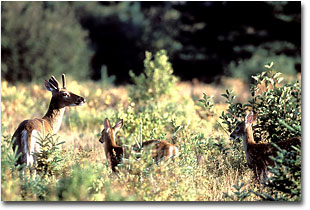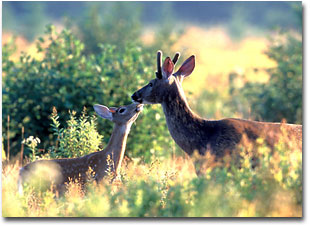The howls of several coyotes pierced the pre-dawn close by the Nesowadnehunk Field Campground at Maine’s Baxter State Park on a recent September morning. From the direction of the calls, you’d have to say that at least three coyotes were communicating to each other.
However, one can never be sure about coyotes-they can throw their voice as a ventriloquist does. That’s part of why early Native Americans called the coyote “trickster” and so counting coyotes by their calls is never a sure thing. One wonders if deer know that.
While suburban dwelling folks probably don’t even think about coyotes unless their cat is missing, some people hate coyotes. Those who dislike them include a number of game hunters who enjoy the pursuit of white-tailed deer.
Coyotes work the deer herd hard in Maine’s big woods, where spruce budworm devastation in the 1970’s and past logging practices resulted in diminished “deeryard” habitat - wintering areas with thick growth softwood and a protective canopy that limits snow depth, so that deer gather there for shelter during the harsher winter months. With marginal deer wintering areas, predation takes a greater toll.
This camera hunter isn’t sure that the way to solve that problem is to kill coyotes, as some advocate. Predators happen to be a part of our natural world. If that world gets out of balance, perhaps we should look harder at ourselves than at the animals for the answers.
In any event, the intensity and several locations of the calls suggested that a number of coyotes lurked in the woods that morning. And that made it unlikely that any self-respecting prey species would show itself in the field by the campground.
 That was too bad. The field at Nesowadnehunk often offers a great opportunity to watch and photograph white-tailed deer because they have less fear of humans there. These deer seem to understand that the people that they meet here are “safe”.
That was too bad. The field at Nesowadnehunk often offers a great opportunity to watch and photograph white-tailed deer because they have less fear of humans there. These deer seem to understand that the people that they meet here are “safe”.
Some might call that habituation. But Percival Baxter, in giving the land to the people of Maine that today comprises the 200,000 plus acre park that bears his name, wanted it to be a home for wildlife. He wanted the animals to feel “safe” with people: “With the protection of wild life the deer, the moose and the birds no longer will fear man and gradually they will come out of their forest retreats and show themselves”
As one who has seriously pursued the whitetail with a camera, my hunch is that their behavior is more influenced by how people behave around them than by how many people that they encounter. Non-threatening postures tell a wild animal a lot – as do threatening ones.
As do predator calls early in the morning, and so it was a surprise to see the first fawn show itself in the field that September morning.
Soon a twin sibling bounced into view. Both fawns still showed bright spots on their coats, the ones that help them to hide from predators as youngsters. Because their coats enable them to blend with the vegetation, they will often lie perfectly still when told to do so by their mother, sometimes even as a threatening predatory animal approaches searching for them.
These two seemed unconcerned about showing themselves in the tall grass of the field that morning. Perhaps they were relying on the greater ability to detect a predator of what appeared to be their older “brother” that late summer day.
 Female deer, especially related ones, band together in small herds. Older “sisters” and “aunts” help oversee the protection of youngsters in these groups. A yearling buck such as this one - judging from its five-inch long spiked antlers - will sometimes hang around with his mother’s doe herd, until the pressures of emerging hormones change his life forever during his second fall.
Female deer, especially related ones, band together in small herds. Older “sisters” and “aunts” help oversee the protection of youngsters in these groups. A yearling buck such as this one - judging from its five-inch long spiked antlers - will sometimes hang around with his mother’s doe herd, until the pressures of emerging hormones change his life forever during his second fall.
The larger deer was more cautious, and looked around the field often. It also kept at a distance that required a 400mm lens to get good pictures.
It’s always better to use a long lens when photographing wildlife, to avoid stressing them – even those that seem to feel safe with humans. Then, take your time to gradually get closer as the animals feel more comfortable with your presence.
With whitetails getting a bit closer can take as long as a half hour- or never. With this young buck it only took five minutes. Imagine this camera hunter’s surprise when he got close enough to learn that the older “brother” was really the two fawn’s mother!
While it’s quite rare, antlered white-tailed does do exist. Biologists believe that this anomaly results from an excess of testosterone that displays itself through antler growth. The short spikes that they produce do not shed the velvet, or blood vessel laden tissue that nurtures the antler growth, but remain encased in it. And – as evidenced by the photographs made that morning two weeks ago – they can reproduce.
Nature does indeed work in strange ways.
Catch yours in the good light.
BS-NPN 012
http://camerahunter.com
Comments on Bill Silliker, Jr.'s The Camera Hunter articles? Send them to the editor.
Maine wildlife & nature photographer Bill Silliker, Jr. – The Mooseman - photographed at many wild places in North America, with the results published in magazines internationally and in 9 of his own books. Bill was an instructor of wildlife and nature photography for L. L. Bean's Outdoor Discovery Program and a member of the Fuji Film Talent Team. Read more about Bill on the Camera Hunter archives page.



